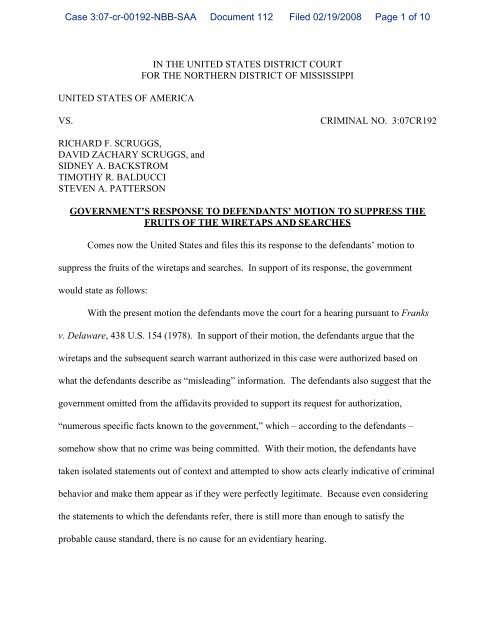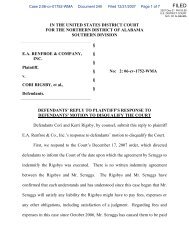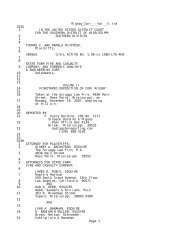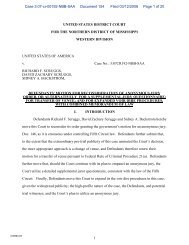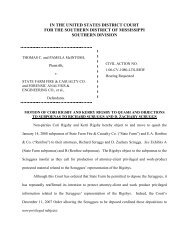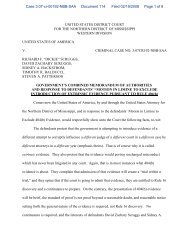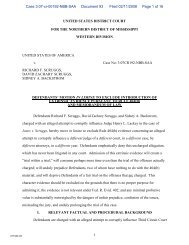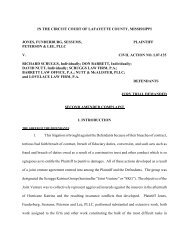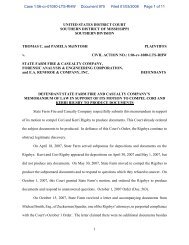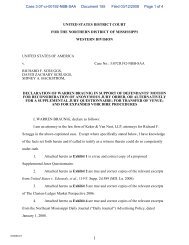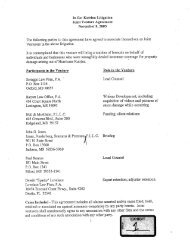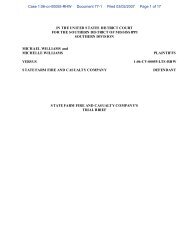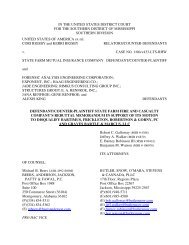motion to suppress the wiretaps - Insurance Coverage Blog
motion to suppress the wiretaps - Insurance Coverage Blog
motion to suppress the wiretaps - Insurance Coverage Blog
You also want an ePaper? Increase the reach of your titles
YUMPU automatically turns print PDFs into web optimized ePapers that Google loves.
Case 3:07-cr-00192-NBB-SAA Document 112 Filed 02/19/2008 Page 1 of 10UNITED STATES OF AMERICAIN THE UNITED STATES DISTRICT COURTFOR THE NORTHERN DISTRICT OF MISSISSIPPIVS.CRIMINAL NO. 3:07CR192RICHARD F. SCRUGGS,DAVID ZACHARY SCRUGGS, andSIDNEY A. BACKSTROMTIMOTHY R. BALDUCCISTEVEN A. PATTERSONGOVERNMENT’S RESPONSE TO DEFENDANTS’ MOTION TO SUPPRESS THEFRUITS OF THE WIRETAPS AND SEARCHESComes now <strong>the</strong> United States and files this its response <strong>to</strong> <strong>the</strong> defendants’ <strong>motion</strong> <strong>to</strong><strong>suppress</strong> <strong>the</strong> fruits of <strong>the</strong> <strong>wiretaps</strong> and searches. In support of its response, <strong>the</strong> governmentwould state as follows:With <strong>the</strong> present <strong>motion</strong> <strong>the</strong> defendants move <strong>the</strong> court for a hearing pursuant <strong>to</strong> Franksv. Delaware, 438 U.S. 154 (1978). In support of <strong>the</strong>ir <strong>motion</strong>, <strong>the</strong> defendants argue that <strong>the</strong><strong>wiretaps</strong> and <strong>the</strong> subsequent search warrant authorized in this case were authorized based onwhat <strong>the</strong> defendants describe as “misleading” information. The defendants also suggest that <strong>the</strong>government omitted from <strong>the</strong> affidavits provided <strong>to</strong> support its request for authorization,“numerous specific facts known <strong>to</strong> <strong>the</strong> government,” which – according <strong>to</strong> <strong>the</strong> defendants –somehow show that no crime was being committed. With <strong>the</strong>ir <strong>motion</strong>, <strong>the</strong> defendants havetaken isolated statements out of context and attempted <strong>to</strong> show acts clearly indicative of criminalbehavior and make <strong>the</strong>m appear as if <strong>the</strong>y were perfectly legitimate. Because even considering<strong>the</strong> statements <strong>to</strong> which <strong>the</strong> defendants refer, <strong>the</strong>re is still more than enough <strong>to</strong> satisfy <strong>the</strong>probable cause standard, <strong>the</strong>re is no cause for an evidentiary hearing.
Case 3:07-cr-00192-NBB-SAA Document 112 Filed 02/19/2008 Page 2 of 10I. DISCUSSIONIn Franks v. Delaware, <strong>the</strong> Supreme Court held that a defendant is entitled <strong>to</strong> anevidentiary hearing <strong>to</strong> contest <strong>the</strong> validity of a search warrant if he makes a substantialpreliminary showing that (1) allegations in a supporting affidavit were a deliberate falsehood ormade with reckless disregard for <strong>the</strong> truth and (2) <strong>the</strong> remaining portion of <strong>the</strong> affidavit is notsufficient <strong>to</strong> support a finding of probable cause. Franks, 4348 U.S. at 156. The Fifth CircuitCourt of Appeals has explained that “even if <strong>the</strong> defendant makes a showing of deliberate falsityor reckless disregard for <strong>the</strong> truth by law enforcement officers, he is not entitled <strong>to</strong> a hearing if,when material that is <strong>the</strong> subject of <strong>the</strong> alleged falsity or reckless disregard is set <strong>to</strong> one side,<strong>the</strong>re remains sufficient content in <strong>the</strong> warrant affidavit <strong>to</strong> support a finding of probable cause.”United States v. Privette, 947 F.2d 1259, 1261 (5 th Cir. 1991) (quoting Franks, 438 U.S. at 171-72).The Fifth Circuit has applied Franks <strong>to</strong> instances of omission where, as here, an affidavitwas provided pursuant <strong>to</strong> 18 U.S.C. § 2518, <strong>the</strong> wiretap statute. See United States v. Tomblin, 46F.3d 1369, 1377 (5 th Cir. 1995) (holding that “[o]missions or misrepresentations can constituteimproper government behavior”). When a defendant argues that possibly exculpa<strong>to</strong>ryinformation was omitted, <strong>the</strong> logic of Privette still applies: a defendant is not entitled <strong>to</strong> anevidentiary hearing if a wiretap authorization would lawfully have issued after correcting <strong>the</strong>supporting affidavit by supplying any material omissions. Therefore, in determining whe<strong>the</strong>r <strong>the</strong>defendants in <strong>the</strong> present case are entitled <strong>to</strong> an evidentiary hearing, <strong>the</strong> Court need onlyconsider whe<strong>the</strong>r an affidavit including <strong>the</strong> statements <strong>to</strong> which <strong>the</strong> defendants refer in <strong>the</strong>ir<strong>motion</strong> satisfies <strong>the</strong> requirements set out in 18 U.S.C. § 2518.2
Case 3:07-cr-00192-NBB-SAA Document 112 Filed 02/19/2008 Page 3 of 101. Balducci September 25 th WireIf <strong>the</strong> affidavits supporting <strong>the</strong> Balducci and Patterson <strong>wiretaps</strong> along with <strong>the</strong> affidavitsupporting <strong>the</strong> search warrant for <strong>the</strong> Scruggs Law Firm were revised <strong>to</strong> include <strong>the</strong> omittedinformation described in <strong>the</strong> defendants’ <strong>motion</strong>, <strong>the</strong> affidavits would describe conversations for<strong>the</strong> most part between Tim Balducci and Judge Henry Lackey. The defendants’ descriptions of<strong>the</strong>se conversations, however, is not accurate. To begin, <strong>the</strong> defendants describe Lackey’srequests as “demands” and that Balducci “relented” <strong>to</strong> such. Putting <strong>the</strong> hyperbole aside, JudgeLackey asked only once whe<strong>the</strong>r Scruggs would help him if he helped Scruggs, <strong>to</strong> which Balduccireplied immediately: “I think, no question that would happen. Yes sir. No question.” JudgeLackey <strong>the</strong>n <strong>to</strong>ld Balducci <strong>to</strong> “talk <strong>to</strong> your man and, just, you know, whatever you need <strong>to</strong> doholler back at me.” Far from “demanding” payment, Judge Lackey went on <strong>to</strong> tell Tim just <strong>to</strong>“think about it and get back with him.” Two days later Balducci contacted Judge Lackey and <strong>to</strong>ldhim he would like <strong>to</strong> meet with him in Calhoun City <strong>to</strong> determine how much “help” Judge Lackeyneeded. At that meeting <strong>the</strong> Judge suggested $40,000 and Balducci agreed, stating such apayment would be “no problem.” Lackey also <strong>to</strong>ld Balducci he could bring <strong>the</strong> order thatScruggs wanted signed. Immediately following <strong>the</strong> meeting at which Balducci agreed <strong>to</strong> pay a$40,000 bribe, Judge Lackey contacted <strong>the</strong> FBI. It was 10:08 A.M. Also, at 10:08 that morning atelephone call was placed from Balducci’s cell phone <strong>to</strong> The Scruggs Law Firm. In o<strong>the</strong>r words,it was perfectly clear that Balducci contacted someone with <strong>the</strong> Scruggs Law Firm immediatelyfollowing his meeting with Judge Lackey. All of this information was included in <strong>the</strong> affidavit insupport of <strong>the</strong> wiretap placed on Balducci’s cell phone signed on September 25 th .The remaining conversations described by <strong>the</strong> defendants show nothing more than3
Case 3:07-cr-00192-NBB-SAA Document 112 Filed 02/19/2008 Page 4 of 10Balducci attempting <strong>to</strong> put Judge Lackey at ease with what had clearly been inappropriatesuggestions. It is undisputed that Balducci was talking with Judge Lackey over a period ofmonths on an ex parte basis <strong>to</strong> discuss a ruling in a case in which Balducci was not counsel ofrecord. Balducci’s initial overtures <strong>to</strong> Judge Lackey included two instances in which he <strong>to</strong>ld <strong>the</strong>Judge once he decided <strong>to</strong> retire that he wanted <strong>the</strong> Judge <strong>to</strong> consider becoming “of counsel” inBalducci’s law firm. These offers were both made contemporaneous with discussions related <strong>to</strong>Judge Lackey’s role in <strong>the</strong> Jones et al. v. Scruggs, et al., with Balducci telling <strong>the</strong> Judge that hewould consider it a personal favor if <strong>the</strong> Judge would enter an order dismissing <strong>the</strong> case againstScruggs.It is true that Balducci <strong>to</strong>ld Judge Lackey that he believed <strong>the</strong> decision he sought was <strong>the</strong>“right one,” but Balducci was <strong>the</strong>re as an advocate. Of course, he said what he believed wouldconvince Judge Lackey <strong>to</strong> rule in Scruggs’s favor. Referring <strong>to</strong> this language <strong>the</strong> defendantsattempt <strong>to</strong> make it appear as if Judge Lackey’s decision was a foregone conclusion; that <strong>the</strong>omitted language showed “Balducci had no motive <strong>to</strong> engage in <strong>the</strong> alleged scheme.” Again, <strong>the</strong>language provided shows nothing of <strong>the</strong> sort. Indeed, it shows <strong>the</strong> decision was not asstraightforward as <strong>the</strong> defendants contend. Actually, Balducci said: “Frankly, I think we’re rightand I think that <strong>the</strong> law is on our side and I think probably had I never even approached you, we’dprobably had <strong>the</strong> right . . . result for us on this thing . . . my goal was simply <strong>to</strong> . . . tell you where,that I had an interest in this thing, and, if I could <strong>to</strong> help guide you <strong>to</strong> where I thought this thing . .. legally could come.” All this language provides is that Balducci was doing what he could <strong>to</strong>influence <strong>the</strong> judge in an illicit manner. It certainly does nothing <strong>to</strong> dispel probable cause when itis seen alongside every o<strong>the</strong>r conversation before <strong>the</strong> Court, including specific discussions related4
Case 3:07-cr-00192-NBB-SAA Document 112 Filed 02/19/2008 Page 5 of 10<strong>to</strong> <strong>the</strong> bribe and <strong>the</strong> amount <strong>to</strong> be paid.Finally, <strong>the</strong> revised affidavit would include Judge Lackey making certain that Tim wouldget credit for a decision rendered in favor of Scruggs. It is unclear how <strong>the</strong> defendants believethis would have an effect on whe<strong>the</strong>r <strong>the</strong> court would find probable cause that a crime was beingcommitted, had been committed, or was likely <strong>to</strong> be committed. Indeed, even <strong>the</strong> defendantsconcede that Judge Lackey wanted <strong>to</strong> make certain Scruggs was aware of what was taking place.The defendants refer <strong>to</strong> <strong>the</strong> following statement made by Judge Lackey <strong>to</strong> Balducci: “I just want<strong>to</strong> hear you say it again . . . . You and Scruggs [are <strong>the</strong>] only one[s] who] know anything aboutthis?” While <strong>the</strong> defendants contend omission of this statement conceals Lackey’s “aggressive”efforts <strong>to</strong> target Balducci, it does nothing of <strong>the</strong> sort, and inclusion of <strong>the</strong> language in <strong>the</strong> affidavitwould have done nothing <strong>to</strong> change <strong>the</strong> fact that probable cause existed that a crime ei<strong>the</strong>r hadbeen committed, was being committed, or would be committed in <strong>the</strong> future.2. Patterson WireWith regard <strong>to</strong> <strong>the</strong> Patterson wire authorized on Oc<strong>to</strong>ber 16, <strong>the</strong> defendants point <strong>to</strong> onlythree additional instances in which <strong>the</strong>y allege <strong>the</strong> government omitted “exculpa<strong>to</strong>ry”information. The first two instances <strong>to</strong> which <strong>the</strong> defendants refer <strong>to</strong>ok place on September 27.First, <strong>the</strong> defendants point <strong>to</strong> a statement provided <strong>to</strong> <strong>the</strong> Court referring <strong>to</strong> P.L. Blake’s possibleinvolvement in <strong>the</strong> crime taking place. The defendants argue that <strong>the</strong> language provided wasdone in such a way as somehow <strong>to</strong> hide <strong>the</strong> fact that P.L. Blake did not know why <strong>the</strong> $40,000was needed. To emphasize that this was simply not <strong>the</strong> case, <strong>the</strong> government quotes <strong>the</strong> entireparagraph from <strong>the</strong> affidavit addressing this issue:(12) On <strong>the</strong> morning of September 27, 2007, Steve Pattersoncalled Timothy R. Balducci at approximately 8:51 A.M. while5
Case 3:07-cr-00192-NBB-SAA Document 112 Filed 02/19/2008 Page 6 of 10Balducci was en route <strong>to</strong> Oxford, Mississippi with intentions <strong>to</strong> pickup a “document” at <strong>the</strong> Scruggs Law Firm before traveling south <strong>to</strong>meet with Circuit Judge Henry L. Lackey. Patterson called using <strong>the</strong>target telephone. Patterson tells Balducci that he has talked with“P.L.” and that he (Patterson) had a “problem” and that he (Patterson)was gonna go ahead and solve <strong>the</strong> problem, and “P.L.” <strong>to</strong>ld Patterson<strong>to</strong> solve it and if he needed any help let him know. Balducci responds,that “well, that’s exactly what I was gonna tell him <strong>to</strong>day, is that I wasjust gonna tell him that I’ve taken care of something you and I havegotten it handled . . . and that I was gonna get, you <strong>to</strong> talk <strong>to</strong> “P.L.”and that he (“P.L.”) knows <strong>the</strong> amount. Balducci asks Patterson“What did you tell him?” Patterson responds “forty”. Patterson tellsBalducci that “P.L.” <strong>to</strong>ld him <strong>to</strong> go ahead and take care of it andPatterson responds that “I said, well we’ve already taken care of halfof it.” Balducci says <strong>to</strong> Patterson that he is going <strong>to</strong> reinforce that thismorning and plans <strong>to</strong> return back through Oxford and meet withScruggs and states that “I’m gonna lead with this issue and <strong>the</strong>n I’mgonna tell him I need you (Scruggs) <strong>to</strong> make two calls.”(Patterson Aff. at 4-5). There is nothing in <strong>the</strong> preceding paragraph <strong>to</strong> suggest <strong>to</strong> <strong>the</strong> Court thatP.L. Blake knew anything about why Patterson and Balducci needed $40,000. Moreover, thiswas an affidavit in support of authority <strong>to</strong> place a wiretap on Steve Patterson’s telephone, not P.L.Blake’s telephone. The affidavit included P.L. Blake as a potential subject because he wasclearly talking <strong>to</strong> o<strong>the</strong>r subjects about <strong>the</strong> money offered <strong>to</strong> bribe Judge Lackey, and informationsubsequently obtained reinforced this belief. Patterson’s statement that Blake did not know whyPatterson and Balducci needed $40,000 was made on September 27. The affidavit was provided<strong>to</strong> <strong>the</strong> Court on Oc<strong>to</strong>ber 16. By Oc<strong>to</strong>ber 16, it appeared even more likely that Blake was involvedin <strong>the</strong> crime. As provided in <strong>the</strong> affidavit, on Oc<strong>to</strong>ber 10, Patterson called Balducci and askedwhen he thought <strong>the</strong> order would be signed. When Balducci asked if <strong>the</strong>re was a problem,Patterson responded that P.L. wanted <strong>to</strong> know. Based on this information, <strong>the</strong>re was certainlyprobable cause <strong>to</strong> believe that Blake would “supply <strong>the</strong> remaining cash <strong>to</strong> be paid and deliveredby Balducci on behalf of Scruggs.”6
Case 3:07-cr-00192-NBB-SAA Document 112 Filed 02/19/2008 Page 7 of 10The defendants next argue that omitting statements Balducci made on September 27“gut[s] <strong>the</strong> government’s <strong>the</strong>ory that Scruggs was a knowing member of <strong>the</strong> alleged conspiracy.”Specifically, <strong>the</strong>se statements are statements Balducci made <strong>to</strong> Judge Lackey that only he andJudge Lackey know “about this.” Again, <strong>the</strong>se are statements omitted from an affidavit insupport of authority <strong>to</strong> place a wiretap on Steve Patterson’s telephone, not Richard Scruggs. Theaffidavit also provided <strong>the</strong> above-quoted conversation that <strong>to</strong>ok place before Balducci made <strong>the</strong>sestatements <strong>to</strong> Judge Lackey, so <strong>the</strong> government knew at <strong>the</strong> time Balducci made <strong>the</strong>m <strong>the</strong>y wereuntrue. Also again, this affidavit was submitted on Oc<strong>to</strong>ber 16. By <strong>the</strong>n, it was certainlyprobable that at least Balducci, Patterson, Blake, and Scruggs were aware of <strong>the</strong> crime.Next, <strong>the</strong> defendants contend that <strong>the</strong> government omitted exculpa<strong>to</strong>ry evidence when<strong>the</strong>y failed <strong>to</strong> include statements made by Balducci describing <strong>the</strong> actual payment of <strong>the</strong> bribe as“that o<strong>the</strong>r deal.” In support of this argument, <strong>the</strong> defendants contend that because Balduccicalled <strong>the</strong> payment “that o<strong>the</strong>r deal,” apart from Judge Lackey actually signing <strong>the</strong> order, thissomehow shows that “Balducci did not understand Lackey’s request for <strong>the</strong> payment <strong>to</strong> beconnected <strong>to</strong> <strong>the</strong> order.” The defendants’ argument is without merit based on <strong>the</strong> numerousinstances provided <strong>to</strong> <strong>the</strong> Court in which Judge Lackey makes specific reference <strong>to</strong> Scruggs andhis case in conjunction with payment of <strong>the</strong> bribe. To suggest that Balducci did not realize <strong>the</strong>$40,000 was in connection with Judge Lackey’s order is nonsense.3. Balducci Extension and Search WarrantFinally, as <strong>to</strong> <strong>the</strong> Oc<strong>to</strong>ber 24 extension of <strong>the</strong> wiretap authorization on Balducci’stelephone and <strong>the</strong> affidavit in support of <strong>the</strong> search warrant of <strong>the</strong> Scruggs Law Firm, <strong>the</strong>defendants simply rely on <strong>the</strong> arguments made with respect <strong>to</strong> <strong>the</strong> initial Balducci wiretap and <strong>the</strong>7
Case 3:07-cr-00192-NBB-SAA Document 112 Filed 02/19/2008 Page 8 of 10Patterson wiretap. As a result, <strong>the</strong> government will not address <strong>the</strong>se argument except <strong>to</strong> say <strong>the</strong>arguments provided supra apply <strong>to</strong> <strong>the</strong> Balducci extension and <strong>the</strong> search warrant.II. CONCLUSIONAn application for a wiretap must demonstrate probable cause <strong>to</strong> believe that <strong>the</strong> target hascommitted, is committing, or will commit a crime, as well as “probable cause for belief thatparticular communications concerning that offense will be obtained through such interception.”18 U.S.C. § 2518(a), (b). The Court determines whe<strong>the</strong>r probable cause exists utilizing a <strong>to</strong>talityof <strong>the</strong> circumstances test. See United States v. Dickey, 102 F.3d 157, 162 (5 th Cir. 1996). Insupport of <strong>the</strong>ir <strong>motion</strong>, <strong>the</strong> defendants point <strong>to</strong> very few isolated portions of conversations duringwhich a practicing at<strong>to</strong>rney and a sitting judge discuss a ruling <strong>to</strong> be made by <strong>the</strong> judge in amultimillion dollar lawsuit. The lawyer is not counsel of record and initiated <strong>the</strong> entireconversation when he called and requested a private meeting with <strong>the</strong> Judge on March 28; <strong>the</strong>lawyer <strong>the</strong>n offered <strong>the</strong> Judge a position of counsel with his firm; explained <strong>to</strong> <strong>the</strong> Judge that aruling in Scruggs’s favor would be a personal favor <strong>to</strong> him; and later faxed <strong>the</strong> Judge a proposedorder sending <strong>the</strong> case <strong>to</strong> arbitration when “<strong>the</strong>y” had decided <strong>to</strong> change <strong>the</strong>ir strategy; <strong>the</strong> lawyer<strong>the</strong>n explained <strong>to</strong> <strong>the</strong> Judge that he would keep <strong>the</strong>se matters secret; and eventually agrees <strong>to</strong> pay<strong>the</strong> Judge $40,000 for a favorable ruling. Despite <strong>the</strong> overwhelming evidence, <strong>the</strong> defendantscontend that <strong>the</strong> few instances in which Tim Balducci attempted <strong>to</strong> put Judge Lackey at easewould have caused <strong>the</strong> Court <strong>to</strong> refuse <strong>to</strong> authorize <strong>the</strong> wiretap, arguing that <strong>the</strong> language <strong>to</strong>which <strong>the</strong>y refer shows that a crime was not even being committed. While <strong>the</strong> defendants maywant <strong>the</strong> Court <strong>to</strong> see Judge Lackey’s request as a “demand” and Balducci’s immediateacceptance as having “relented,” <strong>the</strong> <strong>to</strong>tality of <strong>the</strong> circumstances shows o<strong>the</strong>rwise. Prior <strong>to</strong>8
Case 3:07-cr-00192-NBB-SAA Document 112 Filed 02/19/2008 Page 9 of 10September 27, 2007, <strong>the</strong> defendants had not yet bribed Judge Henry Lackey, but criminal activitywas very much afoot and had been since March.Therefore, in light of <strong>the</strong> numerous instances in which discussions clearly related <strong>to</strong> illegalactivity <strong>to</strong>ok place and <strong>the</strong> context with which <strong>the</strong> statements referred <strong>to</strong> by <strong>the</strong> defendants aremade, <strong>the</strong> reconstructed affidavit would more than establish sufficient probable cause <strong>to</strong> authorize<strong>the</strong> electronic surveillance at issue and <strong>the</strong> subsequent search warrant of <strong>the</strong> Scruggs Law Firm.Accordingly, no evidentiary hearing is required in this matter, and <strong>the</strong> defendants’ <strong>motion</strong> shouldbe denied.Respectfully submitted,JIM M. GREENLEEUnited States At<strong>to</strong>rney/s/ Thomas W. DawsonBy:THOMAS W. DAWSONFirst Assistant United States At<strong>to</strong>rneyMississippi Bar No. 6002/s/ Robert H. NormanBy:ROBERT H. NORMANAssistant United States At<strong>to</strong>rneyMississippi Bar No. 3880/s/ David A. SandersBy:DAVID A. SANDERSAssistant United States At<strong>to</strong>rneyMississippi Bar No. 105359
Case 3:07-cr-00192-NBB-SAA Document 112 Filed 02/19/2008 Page 10 of 10CERTIFICATE OF SERVICEI, DAVID A. SANDERS, Assistant United States At<strong>to</strong>rney, hereby certify that Ielectronically filed <strong>the</strong> foregoing GOVERNMENT’S RESPONSE TO DEFENDANTS’MOTION TO SUPPRESS THE FRUITS OF THE WIRETAPS AND SEARCHES with <strong>the</strong>Clerk of <strong>the</strong> Court using <strong>the</strong> ECF system which sent notification of such filing <strong>to</strong> <strong>the</strong> following:wbraunig@kvn.combdooley@kvn.comeastlandlaw@bellsouth.netngarrett@gbmkc.com<strong>to</strong>dd.graves@pobox.comjkeker@kvn.comtleblanc@kvn.comjlittle@kvn.comrmichael@rmichaellaw.comchrisrobertson@scruggsfirm.comjrt@tannehillcarmean.comtrappf@phelps.comThis <strong>the</strong> _19th_ day of _February__, 2008._/s/ David A. Sanders__________________DAVID A. SANDERSAssistant United States At<strong>to</strong>rney


